
TEAM! Get in here, STAT! We’ve got a 33-year-old male who is unresponsive. We have 12 minutes to run some tests to determine what’s wrong with him. If we’re successful, we can save him. If we fail, he dies… but we can try to save him again after dinner. Sound good? If you’ve always wanted to try working in the hectic environment of an Emergency Room but wanted to avoid naked old people and flying body fluids, then Doctor Panic, a new title from Asmodee’s Repos Production is the game for you.
Doctor Panic is a game for 2-9 players, aged 7 and up and plays in about 12 minutes or less (depending on your selected difficulty).
Summary
A patient has just been admitted to your emergency room. As a doctor, your job is to determine the illness and save the patient before time runs out. Your team must work together to run a battery of tests. When the tests are complete, only then can you save the patient. Move quickly, seconds are ticking by and, above all, despite what the box says… DON’T PANIC!
Components
There is an extraordinary amount of cardboard in the box and some other components that might be described as “unusual.” All of it is top-notch in quality–thick cardboard that’s easily punched and heavyweight cards. It’s all very nice.
I’ll describe the cards and what they do in the gameplay below, but in addition to dozens of different cards, four different playing boards, and some large tiles, there is a handful of items you’ve probably never seen in a boardgame before: there are four oversized plastic forceps (tweezers) for the delicate work required of surgeons in this game; a cardboard needle and bobbin, connected by a real piece of heavy string to represent a suture; a small whoopie cushion (yes, that’s right) to represent the patient’s heart for a CPR task; and there are 9 disposable, emergency-room-green hairnets.
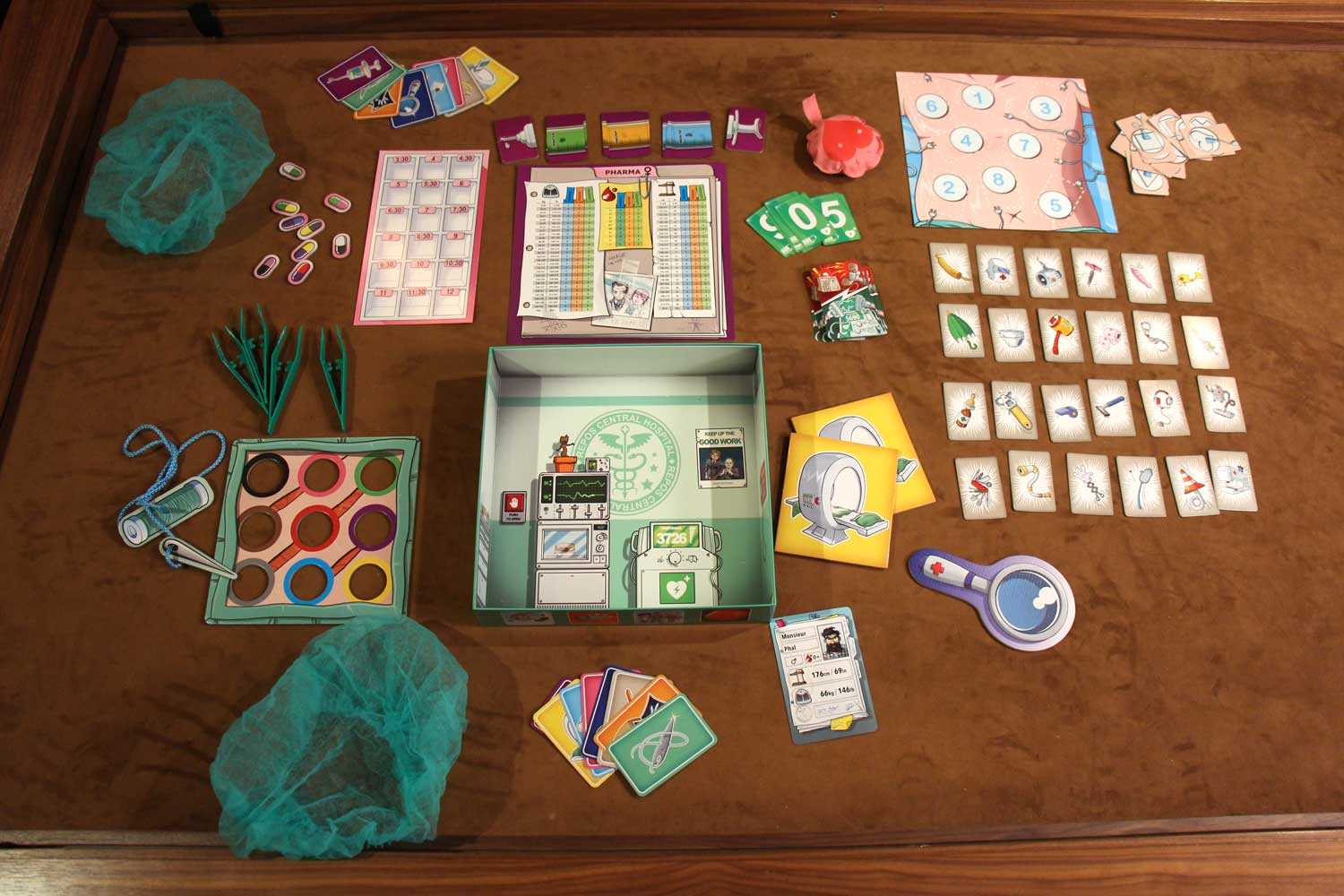
Setup and Gameplay
Before getting started here, there are a couple of, umm, administrative details to point out. The game is meant to be played with a neat-sounding app that plays a soundtrack and provides other information in the game. As I played Doctor Panic ahead of the street date, the app was not ready. There is also a website that has the soundtracks and rules that allow for play without the use of a smartphone, but I’m really eager to give the app a whirl. It sounds like it will really enhance the game. Additionally, the rulebook says you can get a CD with the soundtrack if neither of the other options works for you.
Since there’s a lot going on in the game (eight tests) in the full version, the rulebook suggests an abbreviated and easier version for first-time players. This version uses just four tests. It’s an easy way for you, as a first-year resident, to complete your rotation and become familiar with the demands of gameplay before dealing with the crazy chaos of the full-blown Doctor Panic.
Setup is not that complicated, but takes a little time. There is a nice top-down illustration of a table that’s ready for gameplay and all you have to do is put out the cards and cardboard as indicated in the illustration in the rulebook. Think of your game table as the bed in your exam room. With more than a few games under our belts, I have to recommend moving your chairs out of the way. The game is more fun and takes on some role-play fun if you are moving around the table to work on different tests.
Up to three teams (no more than 3 players each) should be balanced in ages, with the oldest player taking on the role of Head. After shuffling each of the eight stacks of test cards, each Head should take a single card from each stack, shuffle their decks, and place them facedown in front of them. The players should then prep the app for play (or go to the Doctor Panic Web site) and, when ready, press “Go.” After that, it’s time to take a deep breath and pull the curtain; it’s time for triage!
Even though teams are working on different tasks during the game, the goal is cooperative. All teams must complete their tests to win. This is important because once you finish a test, you want to make sure you return the components to their start positions. As time starts to tick away, players should move rapidly to complete the eight tests they are tasked with. The variety of tests ensures no two teams will be performing the same tests and the soundtrack will help move the game along. While the majority of gameplay is performed to the soundtrack of the steady metronome of an electrocardiogram, there are two events that will interrupt your work.

First, if your patient flatlines (a continuous beep), you must immediately stop the task you are working on and and all players shout out “CARDIAC ARREST!” (Or if you want to sound like a pro, call out “CODE BLUE!” or “CALL A CODE!”) A single player prepares to perform cardiac massage by joining their hands above the heart printed on the whoopie cushion. Either by looking at the phone app or a special “Telephone” card, another player identifies a series of numbers for the charge. (All the while, the whoopie cushion is being pumped every second–Pfffrrt! Pfffrrt! Pfffrrt!)
Players rapidly find and arrange the corresponding charge cards to the prescribed sequence and, when the charge cards are correct, players step away from the table and shout out “CLEAR!” Next, they slap the table simultaneously and shout out “JOLT!” If the soundtrack returns to the steady beep of a regular heart rate, they may return to their tasks. If not, they must charge the defibrillator again. (When you play with the app, the shock you make when slapping the table and the sound of yelling influences the length of the cardiac arrest.) Of course, please make sure your table can withstand the force of a half dozen people striking it before playing!
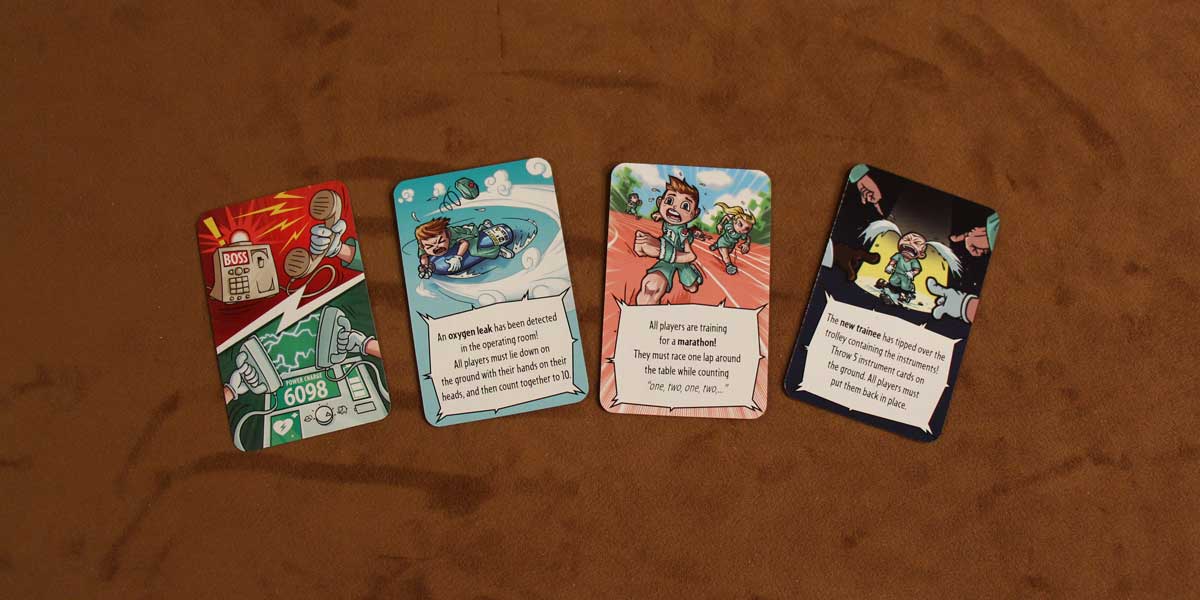
The other interruption in the game comes when the soundtrack lets out a shrill phone ring. It’s the administration calling at the worst possible time, natch. Either by checking the app or looking at a card in the telephone deck, players must all perform a task before continuing their tests. These tasks are varied from “There’s a suspicious odor in the operating room! All players continue the current test while pinching their noses shut” to “The radiation alarm just went off! All players must rush to the nearest bathroom(s), shut themselves in, and count out loud to 10.”
Now, on to those stress-inducing tests. From their decks, each Head should draw, in order, a test card. It’s the Head’s job to instruct their team how to complete the test. This should be done verbally, without any pointing or visual clues. If the Head draws a card that another team is currently working on, they should take that card and move it to the bottom of their pile and move on to the next test. Further, it’s the Head’s responsibility to make sure each test was performed correctly before moving on to the next one.
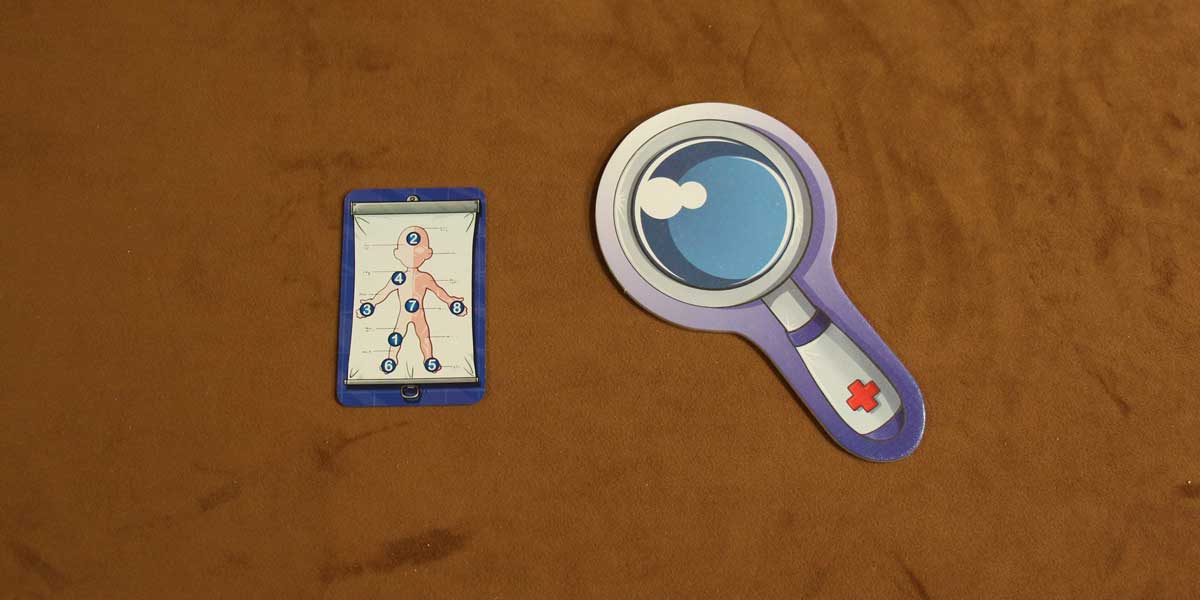
The tests include:
- Examination — One player takes the cardboard magnifying glass. As the Head instructs, the player moves the magnifying glass over his or her body as the Head instructs, according to the test card. Head… right hand… abdomen… left knee, etc. If a team has more than two players, one player should examine another player on their team.

- Prescription — The Head instructs their team where to place nine double-sided pills in a pill case (pink and black pill at 7:30…)
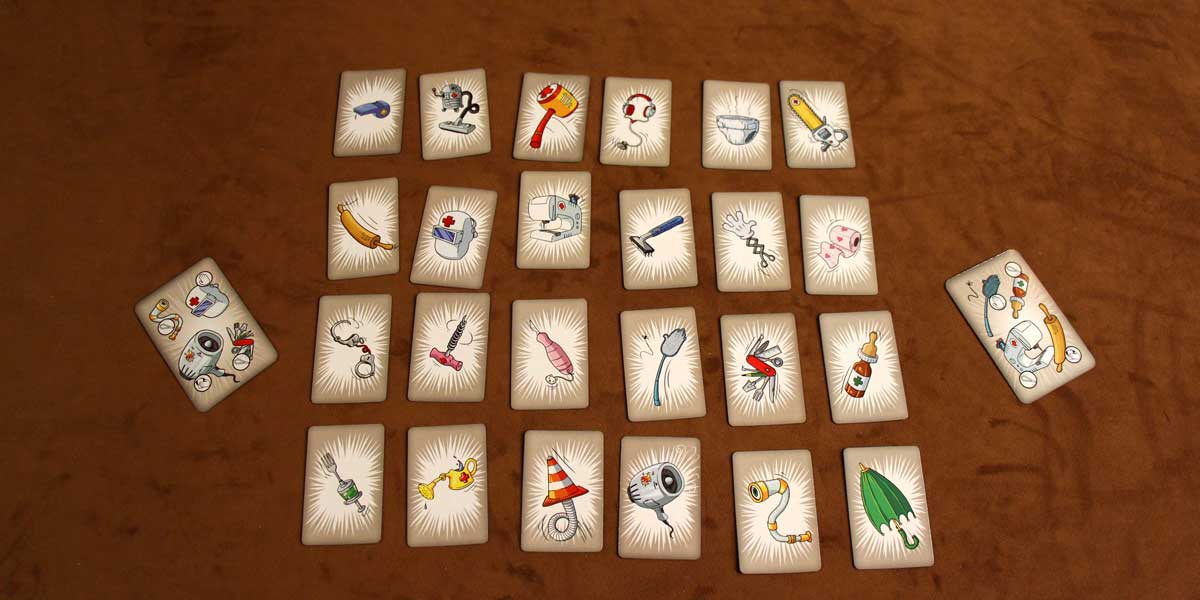
- Instrument — From the test card, the Head requests four instruments that players will find from a grid of 24 instrument cards. The instruments (including welding helmets, whistles, corkscrews, and more) should be passed by hand, clamp (tweezers), or by being sterilized (rubbed between your hands), depending on the icons on the test card.
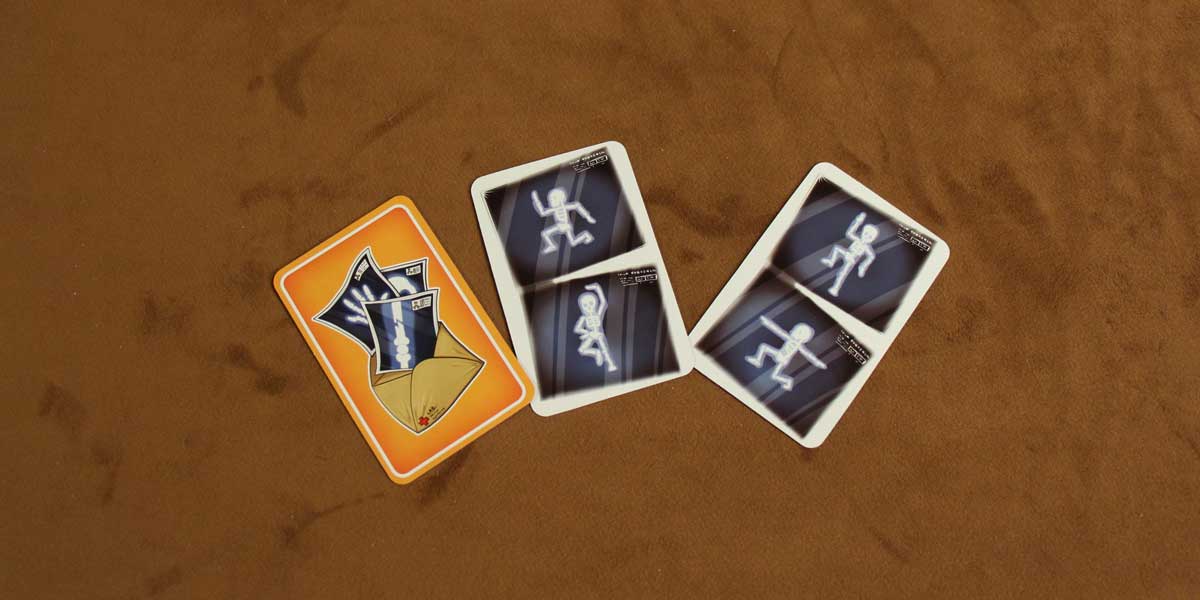
- X-Ray — The Head describes two positions as indicated on the test card. Their team then moves as described. When the correct position is achieved by all players, the Head says “1, 2, 3, X-Ray!” After both positions are achieved, the test is complete.

- Suture – The suture board and needle, twine and bobbin are used in this test, along with two pair of forceps, errrr, tweezers. The Head guides their team in how to stitch up the patient. (Up through the green hole, down through the purple…) The suture must be sterile, though! Players are not allowed to touch the needle or twine with their hands. Tweezers only!
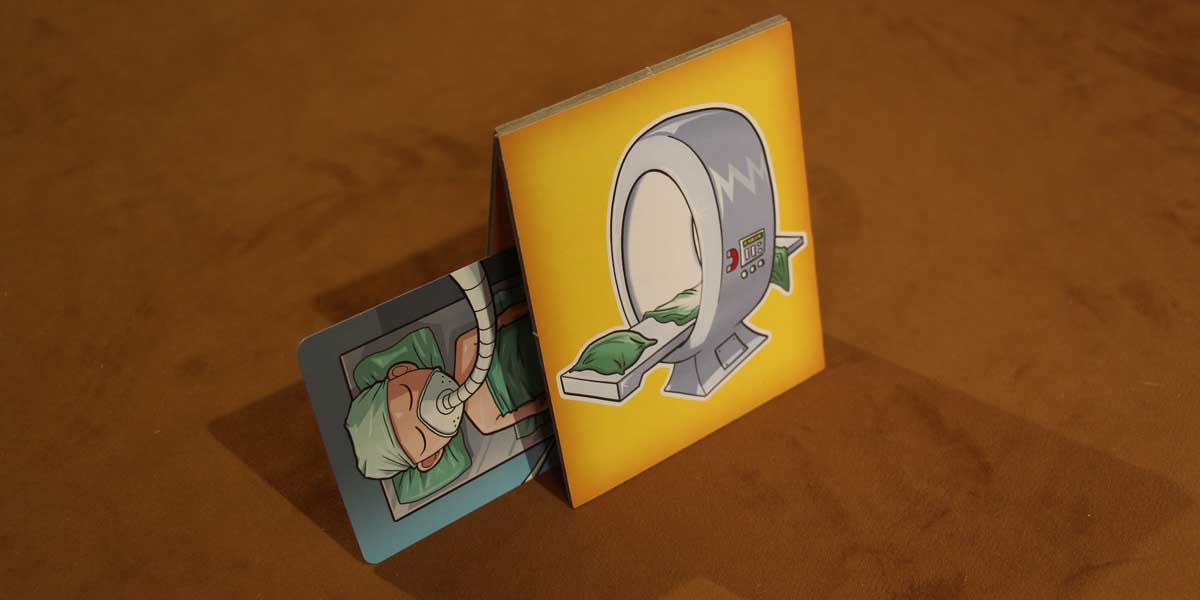
- Scanner — Players must take the two scanner tiles and get them to stand on their own, like a tent. Then, depending on the test card, pass the patient card through from one side to the Head, on the other. The is done by hand or clamp, depending on the test card. If the Scanner collapses at any point the test must be repeated.

- Electrodes — Take the body board and a stack of electrodes with symbols on them. The Head will instruct which electrode goes where on the body (star on 3, square on 7…). Make sure the connectors on the cards and the board match up to complete this test!
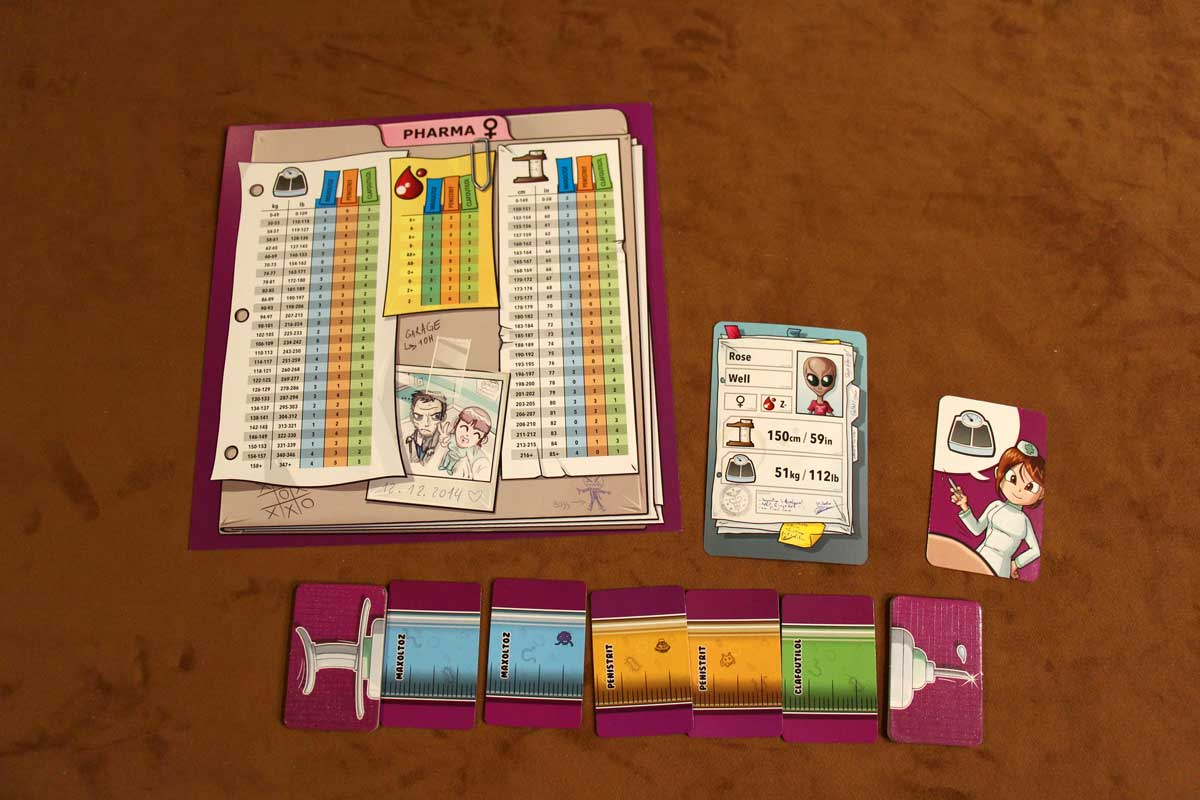
- Injection — This is the most complicated of all the tests. The Head looks at the test card, which tells them to look at one of three patient attributes: height, weight, or blood type. The Head then has to look at the proper side of the Pharma board; one side is for male patients, the other for females. The Head then tells their team the makeup of the injection. There are three basic ingredients and the Head tells the team how many of each ingredient card to put between the needle and the plunger cards.
That’s it. If all the teams complete all their tests before the final “GONG” sounds, you win. Otherwise, your patient dies and it’s off to administrative review and fighting a malpractice suit. (Or resetting the board and trying again, which is the route we always took.) If your team finishes its tasks and other teams are still struggling along, it is within the rules for you to help out the other team, since if all teams don’t finish, no one wins.
Verdict
Doctor Panic is a very short game. All of what I’ve just described takes place in less than 12 minutes and 10 seconds. That’s the longest that the clock will run. And, while you could always play without the clock, the stress and chaos created by a the real-time play and countdown soundtrack really add to the game. Still, like many real-time games that we’ve reviewed here (Fuse, Escape: The Curse of the Temple, Damage Report, etc.), a lot of the fun comes from the manufactured stress of being under a tight time deadline. Doctor Panic is the same. A playthrough without the “beep… beep” soundtrack is not nearly as much fun.
What’s more, this is a game that, every time we finished playing, my kids wanted to play again, immediately. They really loved moving from test to test and doing them as quickly as possible. Almost more than that, the hairnets were a huge hit and they ended up wearing them for most of the day each time we’ve played. I may have to find a medical supply store to get some replacements. And some surgical masks, while I’m at it.
I think a large part of the appeal is that gameplay is so fast and there are so many things to do, games don’t feel very repetitive. You never spend much more than a minute on any task, so there’s always something to do. I think it’s clever that they included a couple of tasks that require a steady hand (suture and scanner). These are a stark contrast to the pace from the manic movements that come out while trying to get tests done quickly and it takes a moment to calm down and take the time necessary to complete the steadier tasks.
While Doctor Panic is a great family game, I can also see where it will have huge appeal as a party game for adults. It’s the right mix of silliness and serious challenge. It’s zany and demanding and, well, whoever thought of the idea of using a small whoopie cushion for cardiac massage is an absolute genius. So many precious seconds will undoubtedly be wasted just giggling about the noises created during the serious business of resuscitating a patient. I really look forward to the inclusion of the smartphone app, as I think it will make the game even better. It’s due to be released when the game hits stores.
There are a couple of variations on the game, both involving additional test cards, that the rulebook suggests. But I think the real way to amp up this dexterity game, to increase the difficulty, is to give extra-large nitrile gloves to all the players and make them play with those on… I think I’ll try that tonight.
Technical assistance for this review was graciously provided by Doctor GeekDad, Gerry Tolbert.
Disclosure: GeekDad was sent a sample of this game for review purposes.



